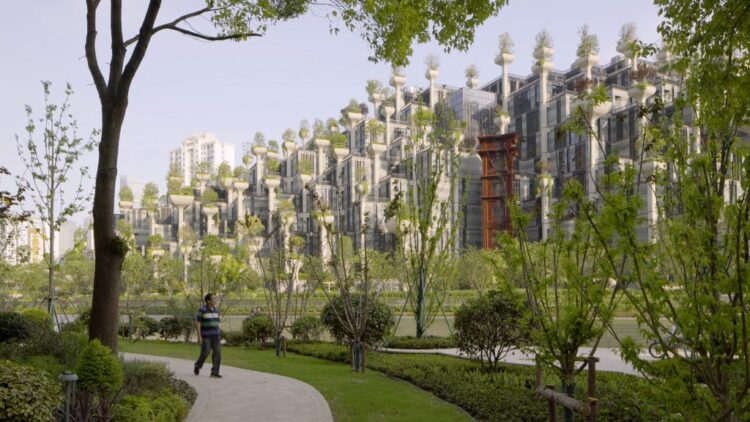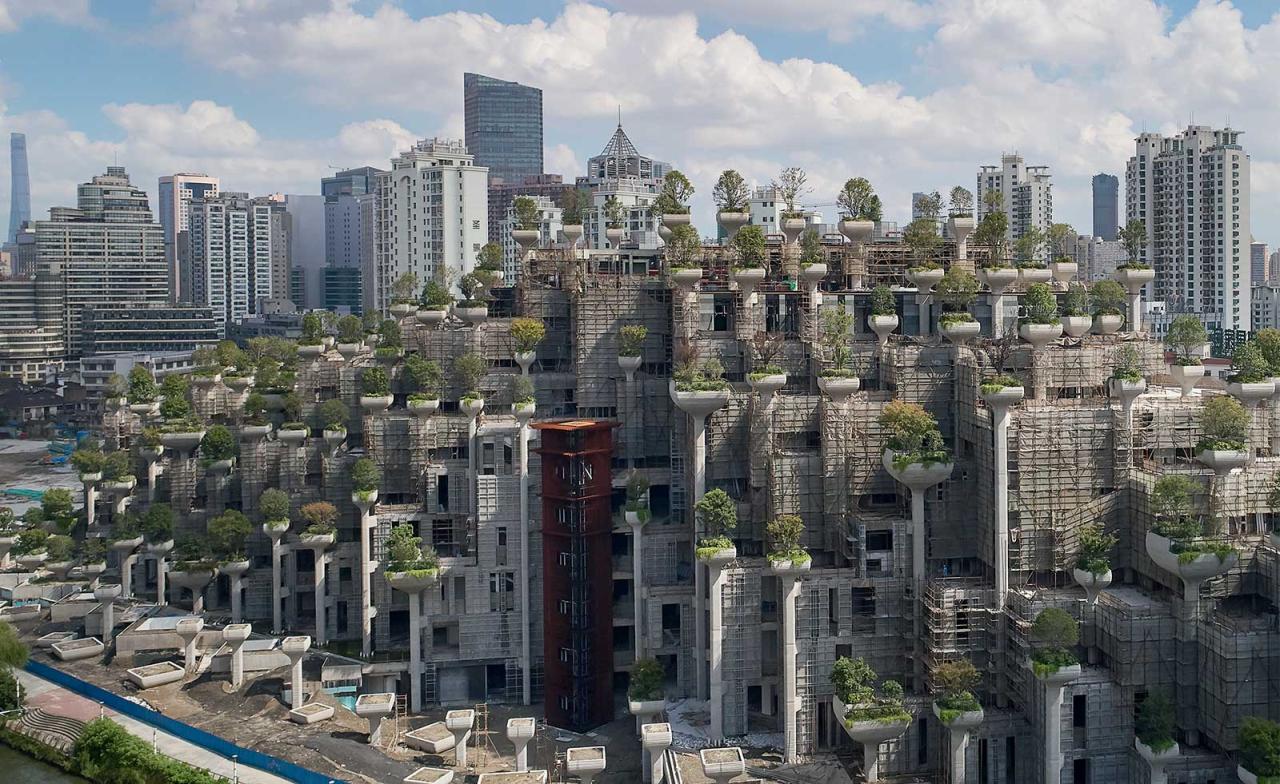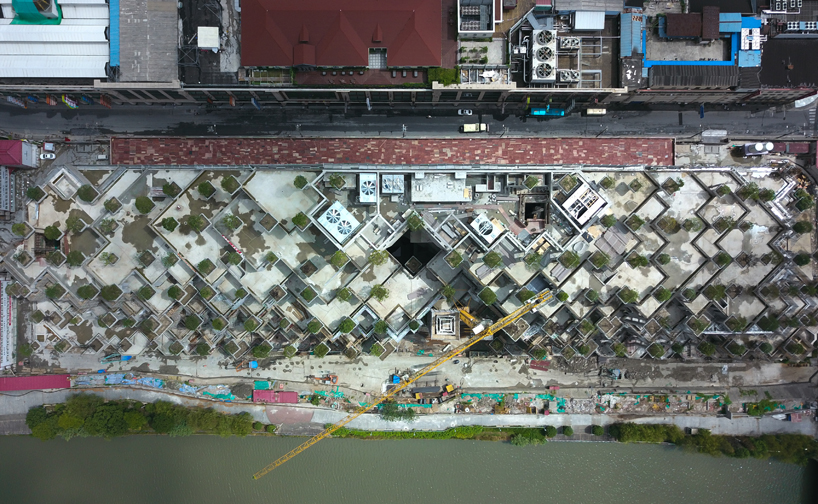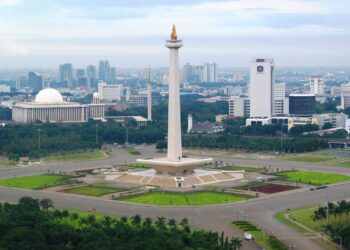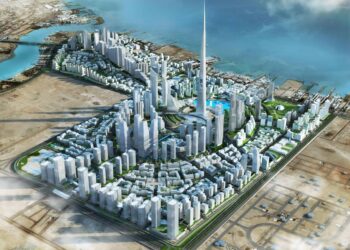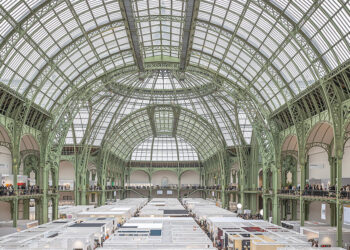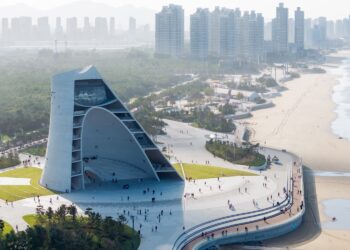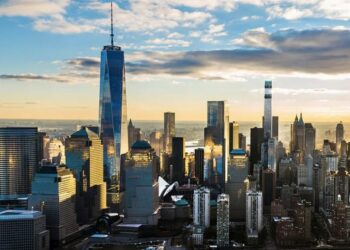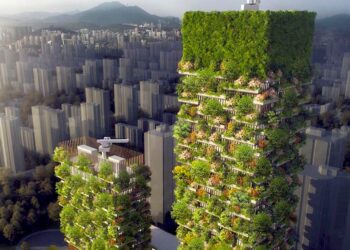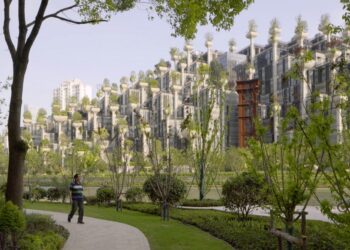In the heart of Shanghai, a groundbreaking architectural endeavor is reshaping the city’s skyline and redefining urban living. The “1,000 Trees” project, conceived by Heatherwick Studio, stands as a testament to innovative design, seamlessly blending nature with urban infrastructure. This mixed-use development not only offers commercial and residential spaces but also integrates over a thousand trees into its structure, creating a living, breathing edifice that challenges conventional architectural norms.
A Visionary Concept: Integrating Nature into Urban Fabric
The genesis of the 1,000 Trees project was rooted in a desire to harmonize urban development with natural elements. Situated along the Suzhou Creek in Shanghai’s Putuo District, the site presented an opportunity to transform a former industrial area into a vibrant, green community space. Heatherwick Studio envisioned a structure that would not only serve functional purposes but also foster a connection between people and nature.
The design draws inspiration from the Hanging Gardens of Babylon, aiming to create a modern interpretation of this ancient wonder. By incorporating trees and plants into the very fabric of the building, the project seeks to blur the lines between architecture and landscape, offering a unique experience to its occupants and visitors.
Architectural Innovation: The Structure of 1,000 Trees
At the core of the 1,000 Trees project lies a structural grid system, where each column serves a dual purpose: supporting the building and housing a planter. This innovative approach results in a pixelated facade, with greenery cascading down the sides, giving the impression of a mountain enveloped in vegetation.
Key Structural Features:
A. Rotated Grid System: The building employs a nine-meter grid, rotated to align with the river and surrounding roads, optimizing views and accessibility.
B. Planter Integration: Each structural column extends beyond the roofline, culminating in a planter that hosts a variety of plant species, including evergreen and deciduous trees, shrubs, and climbers.
C. Material Selection: The use of steel molds with silicone strips for the columns ensures durability while achieving the desired aesthetic texture.
D. Microclimate Creation: The extensive greenery contributes to a cooler microclimate within the development, enhancing comfort for occupants and reducing the urban heat island effect.
Environmental Impact: A Commitment to Sustainability
The 1,000 Trees project exemplifies sustainable urban development by prioritizing ecological considerations throughout its design and construction.
Environmental Initiatives:
A. Biodiversity Enhancement: With over 25,000 individual plants spanning 46 species, the development significantly boosts local biodiversity.
B. Green Space Preservation: Approximately 90% of the existing riverside trees have been preserved, maintaining continuity with the adjacent greenway.
C. Sustainable Sourcing: Plants were sourced from Chongming Island, ensuring the use of native species adapted to the local climate.
D. Energy Efficiency: Natural shading from the vegetation reduces reliance on artificial cooling, contributing to lower energy consumption.
Cultural Integration: Celebrating Art and Heritage
Beyond its architectural and environmental achievements, the 1,000 Trees project pays homage to Shanghai’s rich cultural tapestry.
Cultural Highlights:
A. Artistic Collaborations: The southern facade features murals by 16 local and international artists, transforming the building into a canvas that reflects the city’s vibrant art scene.
B. Heritage Preservation: Historical structures from the site’s industrial past, such as the Fufeng flour mill, have been thoughtfully integrated into the development, preserving the area’s historical narrative.
C. Community Engagement: By incorporating public spaces, galleries, and event venues, the project fosters community interaction and cultural exchange.
Functional Diversity: A Multifaceted Urban Space
The 1,000 Trees development is not merely a visual spectacle; it serves as a dynamic hub for various activities, catering to a diverse range of needs.
Functional Components:
A. Retail and Dining: The complex houses numerous shops and restaurants, offering a variety of options for shopping and culinary experiences.
B. Office Spaces: Modern office facilities provide conducive environments for businesses and professionals.
C. Residential Units: The inclusion of residential spaces allows for a live-work-play lifestyle within the same vicinity.
D. Educational and Cultural Institutions: Schools, galleries, and museums within the development promote learning and cultural appreciation.
Challenges and Criticisms: Balancing Innovation with Practicality
While the 1,000 Trees project has garnered acclaim for its innovative approach, it has also faced scrutiny regarding certain aspects.
Points of Contention:
A. Maintenance Concerns: The upkeep of elevated greenery poses logistical challenges, including irrigation and plant health monitoring.
B. Environmental Efficacy: Some experts argue that while the project introduces green elements, it may not fully replicate the ecological functions of natural ecosystems.
C. Cost Implications: The project’s substantial investment raises questions about cost-effectiveness and resource allocation.
Future Prospects: A Model for Urban Development
The 1,000 Trees project serves as a pioneering model for integrating nature into urban environments, offering valuable insights for future developments.
Lessons and Opportunities:
A. Design Inspiration: Architects and planners can draw inspiration from the project’s innovative integration of greenery and structure.
B. Sustainable Urbanization: The development demonstrates the feasibility of sustainable practices in densely populated urban centers.
C. Community-Centric Planning: By prioritizing public spaces and cultural elements, the project underscores the importance of community engagement in urban design.
Conclusion
The 1,000 Trees project in Shanghai stands as a beacon of architectural innovation, environmental stewardship, and cultural integration. By reimagining the relationship between urban spaces and nature, it offers a compelling vision for the future of city living. As urban areas worldwide grapple with the challenges of sustainability and livability, the lessons gleaned from this development could inform and inspire transformative approaches to urban design.

